These are some of the most interesting cruise ship technology related data and facts - engines, power, marine propulsion systems, fuel consumption of cruise ships, and something about pollution (in-article navigation links).
This cruise vessel technology related survey is integrated with our articles on passenger shipsbuilding and safety, and the statistical ones about registry/flag-states, cost to build, speed, passenger capacity. All ship links redirect to the vessels's "itinerary-schedule-current position" page.
Cruise Ship Engine
Without a source of power, these huge cruise vessels would be nothing more than drifting aimlessly hotels. A large number of older ships use diesel reciprocating engines for generating power for propulsion. Cruise ship engine power is supplied through transmission to the propeller shafts. These transmissions determine the revolutions of propellers. Modern ships use either diesel electric engines or gas turbines as a source of power for propulsion, and for ship's systems. Some of the larger ships depend on two power sources - one for electrical power and one for propulsion.
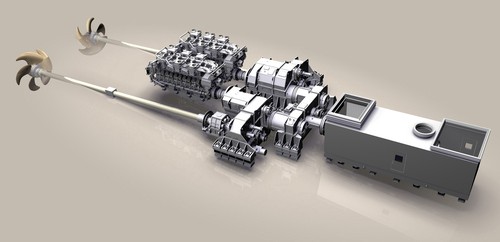
Gas turbine engines, as being aero derivative, generate heat which is transformed from mechanical energy in electrical power. Compressed air is fired in combustion chamber, to achieve this. Hot exhaust is made over a turbine which spins to drive mechanically a shaft. The power can be used to spin the electrical generators. The same way do diesel-electric engines work, yet they use direct drive system, not a turbine. The output shafts, to produce electrical power, are connected to the electrical generators.
Both engine types need a lot of fuel. Cunard QE2, for example, consumes daily 380 tons of fuel when she's traveling at 28.5 knots speed and carries fuel enough to sail for 12 days. Usually ships fill up at various ports, and use fueling barges as floating gas stations. Vessels use lower-grade diesel which tends not to burn as purely as diesel-powered road-going vehicles.
All ships rely on the propellers to be pushed through water. These, referred to commonly as screws, provide forward and reverse motion. Airplanes, for example, require tremendous speeds of propellers to provide forward motion for flight, but ship propellers don't need to turn so fast and rely on torque power. Therefore, they travel slowly, and rarely top 30 knots (for more info follow our speed-link above).
Cruise ship engine room
The basic detail about the cruise ship engine room is its location. Ships' heaviest weights have to be situated at the lowest possible place because of stability, and usually engines are mounted above the keel. Ship's lowest decks are almost entirely full of machinery. An area creating enough power for driving such an enormous vessel through water needs to be really big - very often engine rooms occupy at least three decks. But rather than long halls stretching length of hulls, machinery is almost always divided into smaller compartments - one might house main engines, and another might contain air-conditioning system. This compartmentalization is for safety reasons. If a penetration to the hull or fire happens, multiple compartments help contain the damage. See at the right the Allure of the Seas cruise ship engine room:
Rarely, engines are not placed at the bottom of ship - four main diesel engines on RMS Queen Mary 2, are placed above the keel, and two smaller gas turbines are on top, aft of funnel.
An interesting fact is that it was not unusual for older liners to feature two engine rooms. Gradually, technology allowed consolidation of engine spaces. However, legislation today requires vessels to have equipment duplication and two engine rooms.
Conventional diesel cruise ship engine
Today's direct-drive diesels feature one main advantage - the option to use shaft generator, which is a device using the circular motion of propeller shaft in order to generate electricity needed for hotel services, like cooking and lighting. Shaft generators can be used only while the ship is moving with fairly constant cruising speed. This is what the NCL Epic cruise ship engine looks like:
Diesel electric cruise ship engine
Almost all new ships feature a diesel-electric propulsion form. On these ships, main engines are not connected to propeller shafts, and instead of it they are directly connected to big generators in order to produce electricity, which is sent in turn to electric motors, that then power and help turn the propellers. Main advantage of the diesel-electric cruise ship engine systems is efficiency as they allow main engines to operate near the most efficient speed, no matter if the ship is moving at 5 or 25 knots.
Losing electrical power is devastating to ships. Main engines and generators require electricity and it's needed to keep them going. Pumps that are driven electrically take in cold water from ocean to cool the engines, and electrical pumps get fuel from fuel tanks and supply it to the engine. Electrical power is vital for many operational functions - without it, ships come to a halt.
Large equipment (propulsion motor, bow thrusters) requires electricity of high voltage. As for smaller machinery (cabin lights, galley equipment), the electricity goes through transformer and is thus stepped down into lower voltage. Large cables snake through all the ship to distribute electrical power. They carry power from generators to switchboards, through passageways, public rooms, crew and passenger cabins. Cabling can be the weak point in the distribution system. If the electrical cables aren't truly redundant, even ships that feature two engine rooms suffer power failure.
While ships are docked, generators and main engines produce more power than needed. They are turned off in port, and smaller generators supply "hotel" load (lights, air-conditioning, galley, etc.). Moving through water takes up vast majority of ship's power needs - about 85% of diesel-electric plant produced power goes to propeller, and the rest towards keeping lights on and crew and passengers comfortable. At the right is the Royal Caribbean's major rival's latest cruise ship power technology: the new Vista Carnival cruise ship engine room (engine type is "MAN 2 × 14V48/60CR", common-rail diesel injection system):
Cruise Ship Emergency Generators
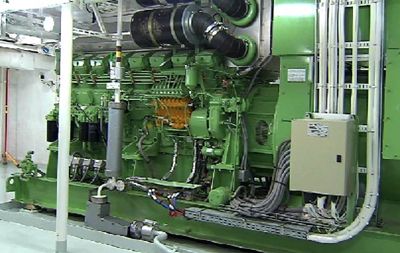 All ships are supplied with emergency generator to maintain vital electrical power. Backup generators are located higher up and also outside engine room spaces to isolate them from damage or fire. Big ships require much power, so they might have more than one emergency generators. Despite that, they don't have the capacity of main generators and engines, don't produce electricity enough to move the ship, and can't supply all the power needed in ports, because of constraints in space. Emergency generators are instead used only for essential navigation systems - crucial communication equipment, critical pumps in engine room, emergency lighting. Should they also fail, vessels are required to have a battery backup. 24 hours of power are at least provided by battery rooms to smaller emergency equipment list.
All ships are supplied with emergency generator to maintain vital electrical power. Backup generators are located higher up and also outside engine room spaces to isolate them from damage or fire. Big ships require much power, so they might have more than one emergency generators. Despite that, they don't have the capacity of main generators and engines, don't produce electricity enough to move the ship, and can't supply all the power needed in ports, because of constraints in space. Emergency generators are instead used only for essential navigation systems - crucial communication equipment, critical pumps in engine room, emergency lighting. Should they also fail, vessels are required to have a battery backup. 24 hours of power are at least provided by battery rooms to smaller emergency equipment list.
Probably you've heard about Carnival cruise ship accidents related to power failures in 2013. At our Carnival Fun Ship 2.0 upgrades link you can learn how Carnival lines battle with this "unmaintained ships" image and implemented revolutionary new technology initiatives fleetwide - including an additional emergency backup generator on each of their vessels.
Cruise Ship Propulsion
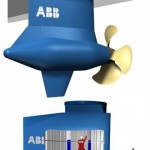 The new cruise ship propulsion systems ABB Azipods XO (photo at the right) are more fuel efficient than the traditional systems, also providing better maneuverability, maximizing speed, reducing bad emissions, which as a whole optimizes the cruise ship's performance and enhances passenger safety.
The new cruise ship propulsion systems ABB Azipods XO (photo at the right) are more fuel efficient than the traditional systems, also providing better maneuverability, maximizing speed, reducing bad emissions, which as a whole optimizes the cruise ship's performance and enhances passenger safety.
New Azipod propulsion systems have major impact on the cruise ship's operating efficiency, reducing energy consumption and bad emissions by up to 20%.
Azipod cruise ship propulsion system
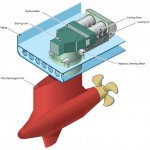 Azipod cruise ship propulsion system is situated outside hull in aft of the ship. Azipod turns in all directions (360 degrees) by a rudder, providing thrust in any directions, not possible for conventional systems. See at the first photo at right the Cunard Queen Mary 2 cruise ship propulsion system scheme:
Azipod cruise ship propulsion system is situated outside hull in aft of the ship. Azipod turns in all directions (360 degrees) by a rudder, providing thrust in any directions, not possible for conventional systems. See at the first photo at right the Cunard Queen Mary 2 cruise ship propulsion system scheme:
The azipod is actually an electric propulsion system consisting of the following main components:
- Propulsion motor - used to produce or drive thrust. Rotating of the propeller is done by help of electric motor.
- Supply transformer - power produced by generators is 6600 KV, that is stepped down to necessary voltage by supply transformer and is provided to the motor in the pod.
- Frequency controller - used to change frequency of supplied power so that rotating motor speed can be controlled.
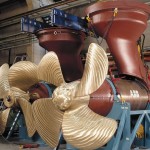
Azipod marine ship propulsion is a combination of both steering and propulsion systems. Conventional marine propulsion systems use two stroke engine connected to shaft, that passes through stern tube and shaft tunnel to connect to the propeller outside hull in aft part of ship. This system's steering is done by help of a rudder in the aft of propeller. At the right photo is the Allure cruise ship propulsion 2 Azipods before mounted onto the hull.
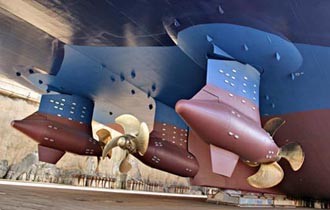
However, the steering and propulsion systems in azipod arrangement, are combined into one part and the system consists of propeller (driven by electrical motor) turned by rudder (that is connected to the azipod system). The motor is inside the sealed pod, connected to propeller. Ath the left photo is the Oasis of the Seas propulsion Azipods.
Advantages of Azipod propulsion marine systems
- A lot of space is saved by Azipod cruise ship propulsion system in the engine room - there is no propeller, engine, shafting or other arrangements. This saved space can be used for storing cargo.
- Great maneuverability - the propeller can turn in all directions and enables crash maneuvering stop distance that is better than conventional system's.
- Azipod cruise ship propulsion system can be placed below ship’s height and provide more efficiency than conventional systems.
- In case the ships have large breadth, two (or more) azipod systems, independent from one another, can be used to provide subtle maneuvering.
- Side thruster's use is eliminated as pods can be used to provide side thrust.
- Low lube oil and fuel consumption.
- Lower vibrations and noise than conventional systems.
- Because emissions are low, it's environment friendly.
Disadvantages of the Azipod marine propulsion
- Requires great initial cost.
- Many diesel generators are needed for producing power.
- Power produced by motor is limited - the maximum available power now is 21 MW.
- Azipod cruise ship propulsion system can't be installed in heavy cargo ships which need large motors and a lot of power.
Quantum-class Royal Caribbean cruise ships propulsion
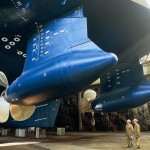 In April 2012 ABB made an US$60 million contract to provide the Azipod propulsion systems for the new Royal Caribbean ships of the Quantum-class - Quantum of the Seas (2014) and Anthem of the Seas (2015). The former name of this vessel design was "Project Sunshine", builder is Meyer Werft (Papenburg, Germany).
In April 2012 ABB made an US$60 million contract to provide the Azipod propulsion systems for the new Royal Caribbean ships of the Quantum-class - Quantum of the Seas (2014) and Anthem of the Seas (2015). The former name of this vessel design was "Project Sunshine", builder is Meyer Werft (Papenburg, Germany).
ABB also supplies the power generation, distribution systems, bow thrusters, and of course, the 2 x 20,500 kW propulsion Azipod XO units (at the photo at right), transformers and drives.
Epic cruise ship pod-propulsion
When entering service in 2004, the Cunard's QM2 was the biggest in the world at 150,000 GR tonnes. Her designer Stephen Payne showed the advantages of pod-propulsion giving vessels increased manoeuvrability. The propellers (screws) of the QM2 ship are mounted on the pods which rotate 360 degrees and provide advanced manoeuvrability. He made the choice to put pods - though relatively new and yet untested for big ships. Royal Caribbean vessels of Oasis, Freedom and Voyager classes have pod-propulsion as many other big ships, which is opposed to the fixed traditional screws which push in one direction only.
An interesting fact about cruise ship propulsion is that Norwegian Epic doesn't have pods, though slightly bigger than Queen Mary 2 (at 153,000 GR tonnes), because of NCL concerns about the new technology. Some of the lines including Celebrity and Cunard have suffered breakdowns because of pod-bearing failures. Lots of voyages had to be cancelled, extensive dry-docking periods required for pod bearings to be replaced, and NCL didn't want to take the risk.
Currently, NCL Norwegian Epic has two rudders conventional non-Azipod screws. But how does she manage to manoeuvre if they can push in one direction only? One option is to make them bigger and more effective when manoeuvring, another is to add additional mini-pods or install full-sized pods. Only time will tell if any of these will actually ever happen.
Rolls-Royce cruise ship propulsion system "Promas Lite"
In November 2013, the manufacturing giant Rolls-Royce upgraded the Hurtigruten's cruise ship ms Richard With with its new, more fuel efficient "Promas Lite" propulsion system (integrated propeller-rudder system). This is an older ship, and Promas Lite was the perfect choice as it is a combined "propeller-rudder" system increasing the efficiency of older passenger ships with lesser tonnage. The upgrade significantly reduced the line's operating costs on this vessel, the improved propeller efficiency was estimated to be between 11-14% at cruising speed of 15 kn (17 mph/28kph).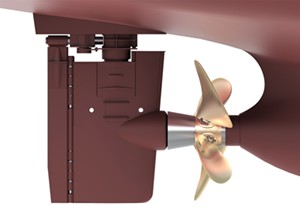

Plus, the Hurtigruten line will be compensated with ~80% of its total investment in the Promas Lite marine propulsion upgrades - the Norwegian Government has this NOx fund encouraging ship owners and operators to upgrade their vessels and invest in new marine technologies reducing the NOx emissions. The Promas Lite propulsion future clients, besides passenger ships, are marine vessels like fishing and freighter ships.
Update 2014: After NCL Norwegian Spirit (the first ship in NCL fleet with installed Promas Lite in 2011), in May 2014 the Star Cruises ship SuperStar Virgo became the first Southeast Asia cruise ship with the RR's Promas Lite propulsion.
Cruise Ship Power
The cruise ship engine power is responsible for driving propellers, and the other possibility is producing electricity that is used subsequently to drive propellers. Engine's effectiveness depends not only on the design but also the shape, weight and size of the ship. Power is measured in horsepower traditionally - one horsepower equals 746 watts.
Marine steam engines
Cruise industry began in 1844, when ships were propelled by steam engines, performing the driving of propellers by using steam as working fluid. The largest passenger steamship (before hitting an iceberg on April 14, 1912) was the Titanic, powered by both reciprocating engines and turbine, able to generate 50,000 horsepower (37 megawatts).
Marine diesel engines
Usually, ships are powered by four or five generator sets (medium-speed, 500 revol. per minute), fueled by diesel and creating 8-10 megawatts energy each. Power density of marine diesel medium-speed engine is 80 kilowatts per cubic meter. Ships that use diesel engines are required to carry exhaust-treatment systems and catalytic-reduction equipment to reduce the environmental impact.
Marine nuclear power engines
The building of the US first and only merchant nuclear-powered ship was commissioned in the 1950s by President Eisenhower. Of total cost $46.9 million, on the fuel core and nuclear reactor was spent more than $28 million. The ship operated only for five years (1965-1970) but due to the high running costs its service was terminated.
Marine gas turbines
The first company that fitted cruise vessels with gas turbines, was Royal Caribbean. Gas turbines are greener than diesel engines and allow ships sailing with reduced inventory and smaller maintenance crew. Gas turbines drive generators which in turn provide electricity to propeller motors. They recover heat from gas turbines' exhaust, which then is used to produce the electricity needed for onboard services (air conditioning, water heating).
Rolls Royce is the manufacturer of the world's largest GAS marine turbine "Rolls-Royce MT30". The turbine will provide the immense 109 MW of power for the 2 propellers, all the weaponry, radars, command sys, etc. of the new generation UK aircraft carriers of the Queen Elizabeth class. To this class belong HMS Queen Elizabeth (to be launched 2017) and HMS Prince of Wales (to be launched in 2020), each of them with a total power consumption of 80 MW.
Gas-turbine cruise ship power system
The first large vessel to use a new gas-turbine cruise ship propulsion system was Celebrity Millennium. This system will be more frequently used in new cruise ship buildings. It's innovative and, besides new activities available, economy of scale, marketing, represents an important element of ship design. System's advantages include:
- lower vibrations and noise level, better comfort, lower probability of failure;
- lower exploitation costs because of the easier maintenance;
- nocive emissions reduction, which is partially owed to gas oil instead of fuel (-90% oxide of sulphur; -80% oxide of azote).
- considerable gain of weight and volume, especially when with Azipod marine propulsion system (900 tons, 70 cabins added).
Gas turbines at this time are only interesting in building of high speed ships (warships, and especially aircraft carriers, or fast passenger vessels - Millennium max speed is 25kn), because of the better diesels' output in lower speed and higher price of gasoil instead of fuel for diesel engines.
Gas turbine cruise ship propulsion systems are able to avoid pre-heating systems needed for fuel in classic installations (risk of fire!), since they use gasoil. 1000 less important quantity of lubrication's oil is needed, too. Besides the other Millenium class ships ordered in Chantiers de l'Atlantique, Vantage class ships that use similar gas systems are the RCI-Celebrity group at Meyer Werft - the Radiance series. This fact is a turn in the search of lower costs for lines and lower prices for passengers, and as gas-turbine ship propulsion system presents other advantages such as comfort and ecology.
Cruise Ship Fuel Consumption
How much fuel do cruise ships use?
Cruise ship fuel consumption depends on ship's size. For most vessels, the average consumption is 30-50 miles on a fuel gallon. This will be also determined by other factors using fuel. Ships' gas mileage varies depending on type and size of ship, the number of the passengers onboard, and other factors. Larger ships need more fuel to move through the water. For example, Queen Mary uses 6 tonnes marine fuel per one hour. Celebrity Eclipse gets 56 feet to gallon. HAL ms Zuiderdam - .0130 miles per gallon (.34 tons fuel per mile). This may not seem very good mileage at first glance, however, cruise ships are moving at once thousands of people whereas a car is moving a few. To analyze the problem with cruise ship fuel consumption closely, it's necessary to consider the way modern ships are being powered.
- Nearly all contemporary ocean liners and cruise ships are powered by electricity - powering motors that turn propellers. It powers air conditioning system, lights and all other appliances aboard the ship.
- Most vessels produce the electricity they need by using diesel engines. Some use gas turbine engines, still others use combination of the two. HFO (heavy fuel oil) is used by diesel engines, while MGO (marine gas oil) is used by gas turbine engines. The MGO is similar to the jet airplanes' fuel.
- Speed affects cruise ship fuel consumption, because in order to go faster, they must increase electricity flow to motors. Thus more engines are employed, and it in turn increases fuel consumption. For example, Queen Mary 2 consumes 237 tons MGO and 261 tons HFO a day when at full spreed. After a certain point, the rate of return decreases from adding engines, because if a ship can manage 17 knots by two engines, it doesn't mean that four engines are going to produce 34 knots.
- Cruise lines employ new technologies in order to reduce fuel consumption. Ship's hull, for example, can be applied by silicon coating in order to reduce frictions as the ship goes through water. Friction reduction on Celebrity Eclipse is 5%. Another experiment is LED lighting, using less energy and producing less heat (thus is reduced the demand for electricity and air conditioning). Celebrity Solstice-class vessels have solar panels' field over the AquaSpa pool area. This not only provides shade for pool area, but the produced by solar panels electricity is used to decrease the electricity demand from ship's engines.
- RMS Queen Mary 2 is equipped with exhaust gas economizers, using waste heat from engines to produce steam. Then steam is used to heat fuel and QM2 hotel accommodations, laundry, galleys. This reduces the energy amount that has to be produced by ship's engines.
- The Promas Lite system (mentioned above) generates cruise ship fuel savings in the range 5-15% depending on the operation type and the actual performance of the ship's existing propeller.
See below how marine ships fuel consumption increases at higher speeds. The infographic shows the speed-fuel consumption relation on container ships (their weight is measured in TEU/20 ft equivalent units), which are similar by speeds and even gross tonnage to cruise passenger ships:

Cruise Ship Pollution
Today cruising is one of the most popular vacations, but there are significant environmental downsides. Mega-ships burn the dirtiest fuel in the world, even if they are sitting in port. Asthma, cancer, respiratory illness, heart disease, are the results of burned in ports nasty bunker fuel.
Those who support cruise industry point out that cruising has never been more popular. However, with the more and more ships come, the more and more pollution that is illness-causing. A solution is to have vessels plug into shore power while docked. Port cities, like Los Angeles and New York, have asked for electrical hook ups. CBS program said that if ships were powered off-grid, electricity was increasingly renewable, like solar and wind. Most importantly, unhealthy emissions can be reduced by 95%.
TUI Cruises Ships Environmental Report
TUI Cruises published company's environmental impact report (first of its kind) including environmental objectives and TUI strategy for 5-years period. TUI said it planned to issue reports every 2 years. According to it, in 2012 TUI reduced by 3.7% per nautical mile its fuel consumption, and expects further 5% reduction, reducing CO2 mission at the same time by 0.5 kg to 0.55 kg per traveler.
Energy efficiencies are the key to reduce fuel consumption, CO2, and other emissions, and contribute to climate protection. Mein Schiff 3, for example, is expected to feature special energy management systems that help to consume 30% less energy than comparable size ships. TUI is focused on reducing recycling and waste, too. In 2012, ships reduced waste amount to 10.7 L per passenger day, which is 27.8% less than previous year. Until end of 2013, is expected another 2L reduction of the waste flow. In 2012, the TUI company used 54,463t fuel, including 9,732t low sulfur fuel oil, 40,880t heavy fuel oil, and 3,851t marine diesel oil. Fuel consumption was 0.367 tons per nautical mile.
You can share/like/rate our review on cruise ship engines, propulsion and fuel via the social buttons. So, now that you know how you ship moves, enjoy freely the motion of the ocean, and the motion with the lotion on your always happy cruise vacations! Kudos to the guys that invent and build all these technology wonders, and one BIG "thank you" to all the crew that operates them - for us to enjoy our perfect time at sea!
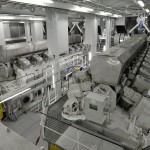
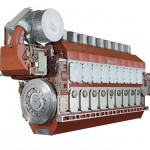
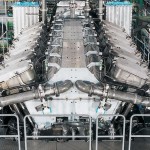
No comments:
Post a Comment